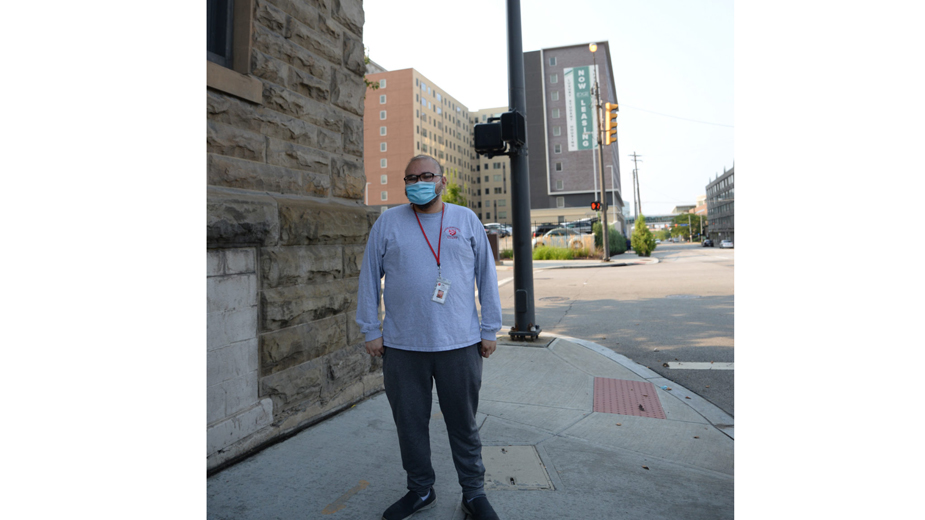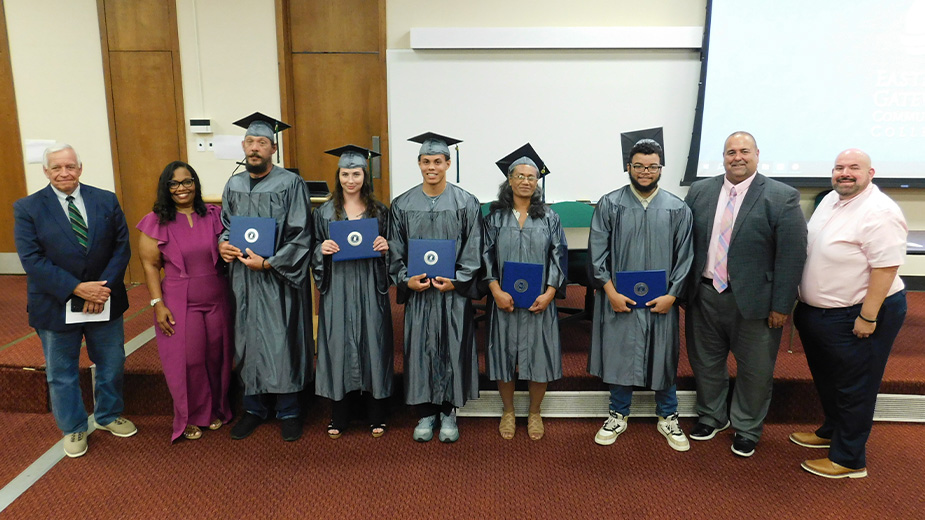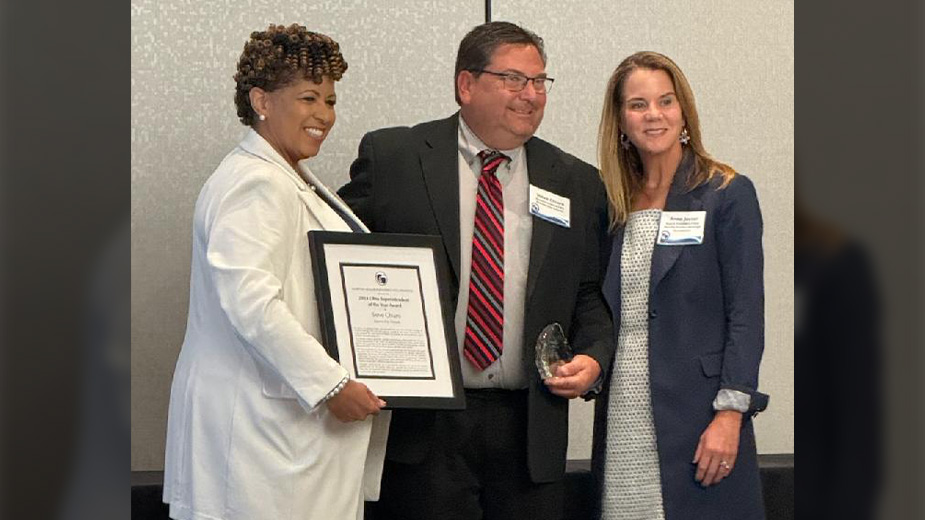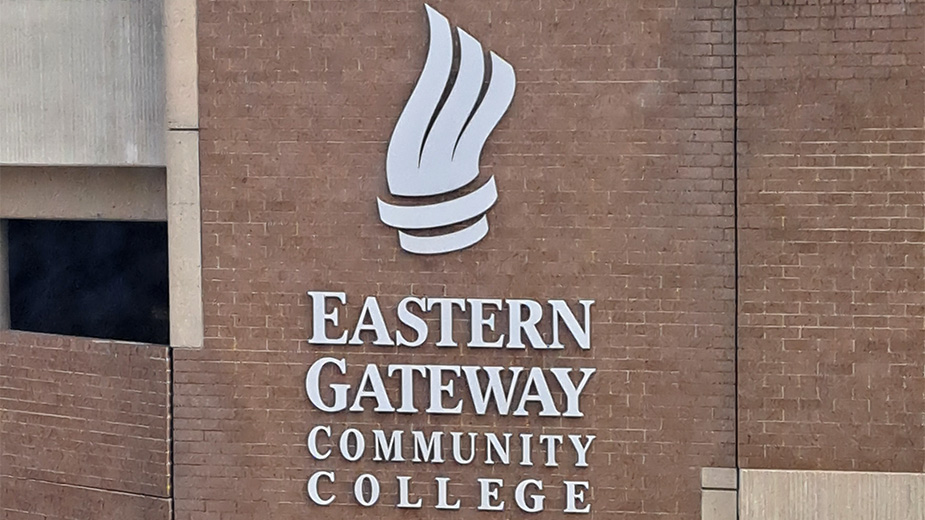How Can Students Learn at Home If They Have Multiple Homes or No Home at All?
Pictured above: Wilber Argueta stands outside the Zelma George Salvation Army Shelter, where he helped organize online tutoring for 12 homeless youth this summer. (Sydney Kornegay)
By Eye On Ohio Staff, Eye on Ohio
CLEVELAND — Sylvia Rucker has been a caretaker most of her life. As the head cook at Hannah Gibbons Elementary School in Collinwood, she prepares meals for approximately 250 students daily, and has four adult children of her own.
But when her oldest daughter died unexpectedly in the summer of 2019, Rucker was suddenly thrust into the role of parent once again.
“My daughter went into the hospital with a toothache. She passed away a week later, and left behind three kids,” says Rucker. “I realized I was going to have to start all over again as a mother.”
Rucker became the primary caregiver for her five-, six-, and 11-year-old grandchildren, all while working full-time. These stresses were compounded in the spring, when COVID-19 forced schools to close and students to stay home.
At that time, Rucker, her sister, and her adult children took turns watching the grandchildren. Rucker would go to work at 5 a.m., then help her grandchildren with homework in the afternoon.
In the midst of shouldering caregiving and work, Rucker learned about the Cleveland Metropolitan School District‘s Project ACT — a program that provides support services to approximately 1,000 children and their families who are either homeless or living with relatives.
About 150 to 200 of Project ACT students are living in homeless shelters. The rest, like Rucker’s grandchildren, are “doubled up” and staying with friends, relatives, or at rotating addresses.
Project ACT works to ensure that these students can continue attending their same schools, regardless of whether their address remains the same throughout the school year.
Studies have found that moving schools in the middle of the year can be detrimental to children’s education, causing them to lose three to six months of learning each time they move.
Project ACT helps prevent disruptions in education by making sure students can stay in their school of choice, even if they don’t have all the paperwork necessary at the start of the school year. Program officials also link students to life skills coaches, who provide emotional and academic support to children in the midst of traumatic life experiences.
While in school, Rucker’s grandchildren met regularly with life skills coach Stefanie Dumperth for 40-minute support sessions.
“I’m there [at the school] to make sure kids know they’re smart and that they can do it,” says Dumperth. “My office was a place of sanctuary for many of them.”
Dumperth says that creating a place of safety for her students allowed her to provide better academic instruction. Rucker echoed this sentiment, calling Dumperth “a lifeline” for her grandchildren.
But when the pandemic hit, Project ACT students found themselves at the crosshairs of both national and personal crises. In response, Project ACT staff members sought to find new ways to create safe spaces for children when they couldn’t meet in person, while ensuring that student’s education wasn’t further disrupted.
Facing the Challenge
Dumperth says that the transition to remote schooling was initially difficult for many of her homeless students.
Many families didn’t have access to reliable internet. Without stable addresses, families couldn’t pursue low-cost internet installations from service providers, or take advantage of desktop giveaways.
Changing addresses and phone numbers also meant schools often didn’t have updated contact information, so not all children received enrichment packets from their schools.
Finally, students lost a key source of support with school closings—the teachers and staff members.
“Once schools closed down, we couldn’t monitor students every day,” explains Dumperth. “We can’t tell if a student has chronic absenteeism or if they’re wearing the same dirty clothes to school.”
As a result, calls to Department of Child and Family Services to report child abuse and neglect dropped by 50% since March.
In response, Project ACT staff worked to ensure that students had the technological capacity to connect not only to their teachers, but also to their life skills coaches.
Staff with Project ACT and the Cleveland school district distributed hotspots and Chromebooks to every one of the 1,000 children they work with.
That way, if a student changed homes or shelters, their technology could move with them.
“I think the [school] district did a really good job of handling the digital divide,” says Dumperth.
Project ACT also gave out gift cards, enrichment packets, school supplies, and hygiene items to students in need. Life skills coaches transitioned their regular emotional support sessions to Zoom—focusing on students who were most at-risk and contacting them to find out what they needed.
Additionally, Project ACT hosted weekly online tutoring sessions for homeless children from three different schools and at the Salvation Army Zelma George Family Shelter.
Wilber Argueta, a children’s activity coordinator at Zelma George, worked with Dumperth to provide academic support throughout the school year and summer.
Wilber says there while there are over 50 school-aged students living in the shelter, he was often the only in-person tutor. Project ACT’s Zoom tutoring provided another source of support.
“I’d work with students on their academic packets in one room, while students had one-on-one Zoom calls with Stefanie in another,” says Wilber. “But without school, our students had low motivation. Only about 12 children attended tutoring regularly. They need the structure of going to school.”
Project ACT also gave supplies and gift cards to help try to engage the students’ parents.
“I’m using the gift cards and school supply giveaways to help throw a pizza party to kick off the school year,” laughs Wilber. “I’m trying to engage the parents and encourage them to come downstairs and help their children.”
“It’s not that parents don’t care about their children’s education,” he asserts. “It’s just that they have a lot going on.”
Wilber says some single moms in the shelter have eight or nine children, and are trying to balance work, searching for new homes, and childcare.
Success and Limitations
Dumperth says that of the 15 students she worked intensively with since the pandemic started, 14 of them were able to continue on to the next grade this year.
Staff in both Zelma George and Project ACT are concerned, though, about the long-term effectiveness of online tutoring and support.
“So many of my students were so far behind already,” says Wilber. “I have one kid who is in sixth grade and can’t even read, and now will be even further behind.”
Rucker echoes this fear for her grandchildren. “They’re all going to be expected to logon from 8:30 a.m. to 3:30 p.m. and focus the whole day,” says Rucker. “It’s going to be interesting. Very interesting.”
Online meetings also don’t provide the same safety and security as the privacy of an office. “There are things students would tell me in the office that they just don’t feel comfortable saying through a computer while there are others around,” says Dumperth.
The need for online tutors also far outstrips Project ACT’s staff. With only 14 life skills coaches for 1,000 students, each elementary coach will be responsible for 30 to 50 students, while high school coaches will juggle 100 students. Even then, Project ACT will need to focus only on the most vulnerable or far-behind students at each of the schools.
And while online tutoring may help provide academic assistance when caregivers can’t provide it, it doesn’t solve the problem of childcare. Many single mothers who do not have the help of other family members will not be able to return to work until their children return to school.
It’s a series of challenges that Project ACT director Marcia Zashin says her team is committed to working through.
“I want people to remember that our children have done nothing wrong,” she says. “We will be there to continue working with students who need us the very most.”
It’s a sentiment echoed by Rucker. Asked where she draws the inspiration to continue balancing work and grandchildren, she says without hesitation, “Them. It’s all for them.”
This story is sponsored by the Northeast Ohio Solutions Journalism Collaborative, composed of 16-plus Greater Cleveland news outlets including Eye on Ohio, which covers the whole state.
This article first appeared on Eye on Ohio and is republished here under a Creative Commons license.
Published by The Business Journal, Youngstown, Ohio.



